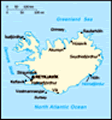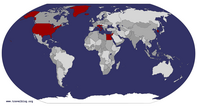Advertisement
Published: August 27th 2019
We had alot to do today - and all of it in cold, windy, driving rain.
After all the participants of the tour with Arctic Adventures were picked up, we were on our way. Our guide is Sindri, and he is the driver and guide for this trip. He is a wealth of information and he talks the whole time he is driving through this horrible rain.
My cousin said all the photos are not coming through. I don't know why, maybe the wi-fi connection? Sorry about that.
I killed you with iceberg photos, now I'm going to kill you with waterfall photos.
First stop: Thingvellir.
From Wikipedia:
Þingvellir (Icelandic:
(
 listen
listen)), anglicised as
Thingvellir,
is a
national park in the municipality of
Bláskógabyggð in southwestern
Iceland, about 40 km northeast of Iceland's capital,
Reykjavík. Þingvellir is a site of historical, cultural, and geological significance, and is one of the most popular tourist destinations in Iceland. The park lies in a
rift valley that marks the crest of the
Mid-Atlantic Ridge and the boundary between the
North American and
Eurasian tectonic plates. To its south lies
Þingvallavatn, the largest natural lake in Iceland.
Þingvellir is associated with the
Althing, the national parliament of Iceland, which was established at the site in 930 AD. Sessions were held at the location until 1798.
This place is right on the rift zone of the 2 plates. There are diagrams indicating where you are standing and which plate you are on. You can walk right through a fault. Also significant is the fact that the parliament was held here for over 800 years. The way our guide explained it is that the Vikings went to Iceland to get away from Harold Fairhair, war, taxes, and they had plantable land that they didn't have to clear the trees from. Paradise for them. So when they settled Iceland they wanted a more fair way of governing than what they had been subject to in Norway, so they created this parliament, had representatives from all over the island, and met each year in the summer for 2 weeks. This is a World Heritage Site and a National Park.
From Wikipedia: Although the duties of the assembly were the main reason for going there, ordinary people gathered at Þingvellir for a wide variety of reasons. Merchants, sword-sharpeners, and
tanners would sell their goods and services, entertainers performed, and ale-makers brewed drinks for the assembly guests. News was told from distant parts; games and feasts were held. Young people met to make their plans, no less than leading national figures and experts in law. Itinerant farmhands looked for work and vagrants begged. Þingvellir was a meeting place for everyone in Iceland, laying the foundation for the language and literature that have been a prominent part of people's lives right up to the present day.
Next stop: Gullfoss
From Wikipedia:
Gullfoss ("Golden Falls";
 Icelandic pronunciation
Icelandic pronunciation (
help·
info)</small>😉 is a
waterfall located in the
canyon of the
Hvítá river in southwest
Iceland. The wide
Hvítá river flows southward, and about a kilometre above the falls it turns sharply to the right and flows down into a wide curved three-step "staircase" and then abruptly plunges in two stages (11 metres or 36 feet, and 21 metres or 69 feet) into a crevice 32 metres (105 ft) deep. The crevice, about 20 metres (66 ft) wide and 2.5 kilometres (1.6 mi) in length, extends perpendicular to the flow of the river. The average amount of water running down the
waterfall is 140 cubic metres (4,900 cu ft) per second in the summer and 80 cubic metres (2,800 cu ft) per second in the winter. The highest flood measured was 2,000 cubic metres (71,000 cu ft) per second.
I have seen many pictures of this waterfall and I wasn't disappointed. Just extremely wet. This is the theme of today because not only is there lots of water going over these waterfalls, but the wind is whipping the water all over the place.
Next stop: The Geysers (Geysir here). OK - I've been to Yellowstone with all the geysers. For me this was no big deal. One geyser, Strokkur, erupts every 5-7 minutes. I watched it a few times, walked around and went to lunch. It's neat for people who have never seen a geyser before.
From Wikipedia:
Geysir (Icelandic pronunciation:
(
 listen
listen)), sometimes known as
The Great Geysir, is a
geyser in southwestern
Iceland. It was the first geyser described in a printed source and the first known to modern Europeans. The
English word
geyser (a periodically spouting
hot spring) derives from Geysir. The name
Geysir itself is derived from the
Icelandic verb
geysa ("to gush") the verb from
Old Norse. Geysir lies in the
Haukadalur valley on the slopes of
Laugarfjall hill, which is also the home to
Strokkur geyser about 50 metres (160 ft) south.
Next stop: Seljalandsfoss. The waterfall drops 60 m (197 ft) and is part of the
Seljalands River that has its origin in the volcano glacier
Eyjafjallajökull. Visitors can walk behind the falls into a small cave.
This was impressive. The water pours over the tephra and I walked behind it. Made for good photography, except when I forgot to wipe the water off my lens on my phone.
Next stop: Skogafoss.
From Wikipedia:
Skógafoss (pronounced
(
 listen
listen)) is a waterfall situated on the Skógá River in the south of
Iceland at the cliffs of the former coastline. After the coastline had receded seaward (it is now at a distance of about 5 kilometres (3.1 miles) from
Skógar), the former sea cliffs remained, parallel to the coast over hundreds of kilometres, creating together with some mountains a clear border between the coastal lowlands and the
Highlands of Iceland. The Skógafoss is one of the biggest waterfalls in the country with a width of 15 metres

 Gullfoss
Gullfoss
Foss means waterfall so if I labeled this Gullfoss waterfall I would be calling it Gull waterfall waterfall.(49 feet) and a drop of 60 m (200 ft). Due to the amount of spray the waterfall consistently produces, a single or double
rainbow which is normally visible on sunny days.
No rainbows today but got pretty wet taking photos.
Next stop: Reynisfjara Black Sand Beach
From Wikipedia: In 1991, the US journal
Islands Magazine counted this beach as one of the ten most beautiful beaches on Earth. Its stretch of black
basalt sand is one of the wettest places in Iceland. The cliffs west of the beach are home to many seabirds, most notably
puffins which burrow into the shallow soils during the nesting season. Offshore lie
stacks of basalt rock, remnants of a once more extensive cliffline
Reynisfjall, now battered by the sea. There is no landmass between here and Antarctica and the Atlantic rollers can attack with full force. According to folklore, they are former
trolls who tried to drag their boats out to sea only to be caught by the rising dawn. The sea around them is rather wild and stormy, so travelers will not be surprised to discover a monument to the memory of drowned seamen on the beach.
We
didn't see puffins, apparently they have migrated. There is a phenomenon here called "sneaker waves" that sneak up on you while you are standing on the beach. They have had several fatalities from people being caught unaware and being washed out to sea. This storm is a crazy one and the waves were wild and crashing. The beach has columnar basalt also.
We drove through Vik but did not stay there. Here's an interesting fact about Vik: Vík lies directly south of the
Mýrdalsjökull glacier, which itself is on top of the
Katla volcano. Katla has not erupted since 1918, and this longer than typical dormant period has led to speculation that an eruption may occur soon. An eruption of Katla could melt enough ice to trigger an enormous flash flood, potentially large enough to obliterate the entire town. The town's church, located high on a hill, is believed to be the only building that would survive such a flood.
Thus, the people of Vík practice periodic drills and are trained to rush to the church at the first sign of an eruption. The town has 1,400 hotel rooms for scientists and
tourists, who are also briefed about Katla's dangers.
Also, we drove by the Eyjafjallajökull volcano
, the one that erupted in 2010 and shut down air traffic in Europe for about a week, but with the storm and clouds and fog we couldn't see it.
We finally made it to our hotel about 18:40. Unfortunately it's supposed to rain tomorrow also. I spread my clothes and hiking boots out in the room to dry everything off to get it ready for the next day. Don't think I'll see the Aurora either. Unfortunately the only meal included in this tour is breakfast, so it's getting expensive to buy food. My cod dinner was $35 and beer $9.80.
Advertisement
Tot: 0.112s; Tpl: 0.018s; cc: 12; qc: 28; dbt: 0.0374s; 1; m:domysql w:travelblog (10.17.0.13); sld: 1;
; mem: 1.2mb










 Maroon
Maroon 














